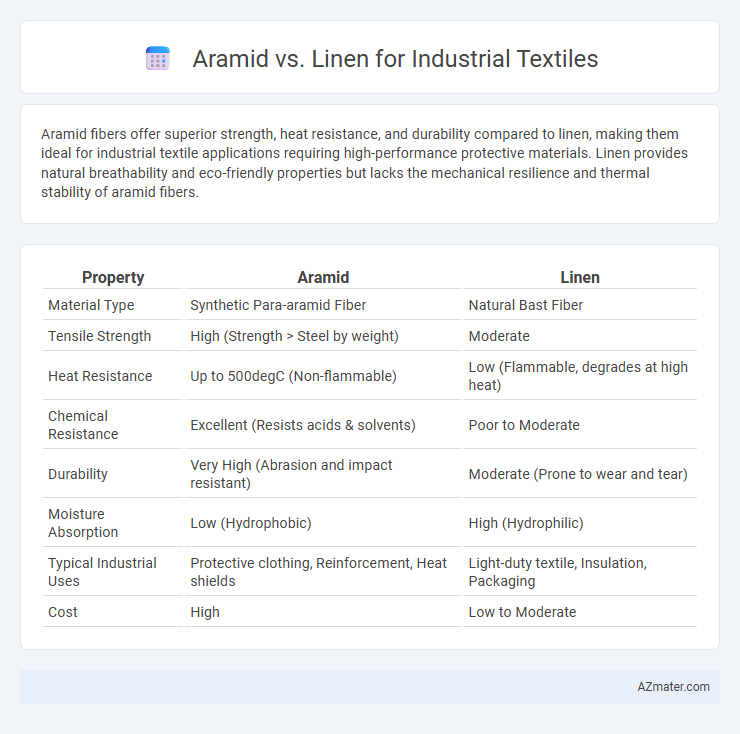Aramid fibers offer superior strength, heat resistance, and durability compared to linen, making them ideal for industrial textile applications requiring high-performance protective materials. Linen provides natural breathability and eco-friendly properties but lacks the mechanical resilience and thermal stability of aramid fibers.
Table of Comparison
| Property | Aramid | Linen |
|---|---|---|
| Material Type | Synthetic Para-aramid Fiber | Natural Bast Fiber |
| Tensile Strength | High (Strength > Steel by weight) | Moderate |
| Heat Resistance | Up to 500degC (Non-flammable) | Low (Flammable, degrades at high heat) |
| Chemical Resistance | Excellent (Resists acids & solvents) | Poor to Moderate |
| Durability | Very High (Abrasion and impact resistant) | Moderate (Prone to wear and tear) |
| Moisture Absorption | Low (Hydrophobic) | High (Hydrophilic) |
| Typical Industrial Uses | Protective clothing, Reinforcement, Heat shields | Light-duty textile, Insulation, Packaging |
| Cost | High | Low to Moderate |
Introduction to Aramid and Linen in Industrial Textiles
Aramid fibers, known for their exceptional strength, heat resistance, and durability, are extensively used in industrial textiles for applications requiring high-performance protective gear, automotive components, and aerospace materials. Linen, derived from flax plants, offers natural breathability, moisture-wicking properties, and biodegradability, making it suitable for eco-friendly industrial textiles and lightweight protective fabrics. The choice between aramid and linen depends on specific industry requirements such as durability, thermal resistance, and environmental sustainability.
Material Composition and Origins
Aramid fibers, composed primarily of aromatic polyamides like Kevlar and Nomex, are synthetic materials known for their exceptional strength, heat resistance, and durability, originating from petrochemical sources developed in the 1960s. Linen, derived from the flax plant (Linum usitatissimum), is a natural fiber composed mainly of cellulose, valued for its breathability and biodegradability, with a history dating back thousands of years in traditional textile use. The fundamental difference in material composition--organic cellulose for linen versus synthetic aromatic polymers for aramid--defines their distinct performance characteristics and applications in industrial textiles.
Mechanical Strength Comparison
Aramid fibers exhibit significantly higher tensile strength and impact resistance compared to linen, making them ideal for demanding industrial textile applications requiring durability. Linen, derived from the flax plant, offers moderate mechanical strength but excels in flexibility and moisture-wicking properties. In scenarios where maximum mechanical strength and heat resistance are critical, aramid-based textiles outperform linen, supporting their use in protective gear and high-performance composites.
Thermal and Fire Resistance Capabilities
Aramid fibers exhibit superior thermal stability and fire resistance, maintaining structural integrity at temperatures up to 500degC, making them ideal for industrial applications requiring high heat endurance. Linen, derived from flax fibers, offers limited thermal protection with flammability at lower temperatures and lacks the inherent fire-resistant properties comparable to aramid fibers. Industrial textiles demanding enhanced safety and durability under extreme heat conditions predominantly favor aramid due to its exceptional resistance to ignition, combustion, and thermal degradation.
Durability and Longevity in Industrial Applications
Aramid fibers exhibit superior durability and longevity compared to linen in industrial textile applications due to their exceptional resistance to heat, abrasion, and chemical exposure. Aramid materials maintain structural integrity under extreme conditions, making them ideal for protective clothing, conveyor belts, and reinforcement fabrics. In contrast, linen, while biodegradable and breathable, lacks the tensile strength and thermal resistance required for demanding industrial environments, resulting in shorter service life.
Flexibility and Comfort Factors
Aramid fibers provide superior durability and heat resistance in industrial textiles but tend to be less flexible and breathable compared to linen. Linen offers enhanced comfort due to its natural moisture-wicking properties and flexibility, making it suitable for applications requiring soft, breathable materials. Balancing flexibility and comfort with protection needs often dictates the choice between aramid and linen in specialized industrial uses.
Environmental Impact and Sustainability
Aramid fibers offer high strength and durability but are petroleum-based, resulting in higher carbon emissions and limited biodegradability compared to natural linen fibers. Linen, derived from flax plants, provides a more sustainable option with lower environmental impact due to renewable resources, biodegradability, and reduced water and pesticide requirements. Choosing linen for industrial textiles supports eco-friendly production and end-of-life disposal, while aramid remains essential for applications requiring extreme heat and chemical resistance despite environmental trade-offs.
Cost Analysis and Economic Considerations
Aramid fibers, while offering superior strength and heat resistance for industrial textiles, come at a significantly higher cost compared to linen, which is more affordable due to its natural fiber origin and simpler manufacturing processes. Linen's lower price point makes it economically attractive for applications with less stringent durability requirements, although aramid's longevity can lead to lower replacement frequency and overall life-cycle costs. Businesses must weigh the upfront investment in aramid textiles against potential savings in maintenance and product lifespan when performing cost-benefit analyses for industrial use.
Common Industrial Uses and Case Studies
Aramid fibers, known for their exceptional heat resistance and tensile strength, are commonly used in protective clothing, aerospace, and automotive industries where durability and flame retardance are critical. Linen, derived from flax fibers, excels in industrial applications requiring breathability and moisture-wicking properties, such as filtration systems and upholstery. Case studies reveal aramid's superior performance in ballistic protection gear and fire-resistant uniforms, while linen is favored in eco-friendly packaging and composite materials for lightweight automotive components.
Conclusion: Choosing Between Aramid and Linen
Aramid fibers offer exceptional heat resistance, high tensile strength, and superior durability, making them ideal for demanding industrial applications requiring flame retardancy and impact protection. Linen provides natural breathability, moisture-wicking properties, and environmental sustainability, suited for lighter-duty industrial uses where comfort and eco-friendliness are prioritized. Selecting between Aramid and Linen depends on specific performance requirements such as thermal resistance, mechanical strength, and sustainability goals in the intended industrial context.

Infographic: Aramid vs Linen for Industrial Textile
 azmater.com
azmater.com